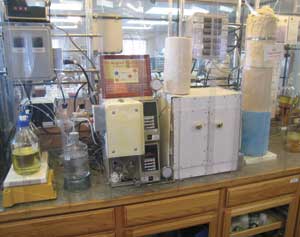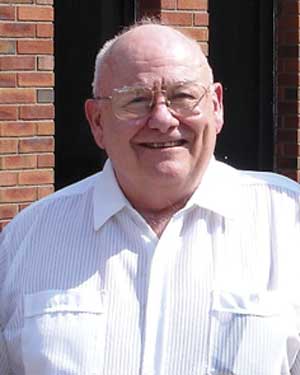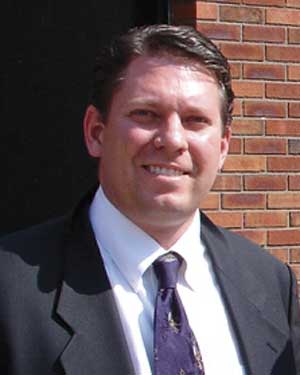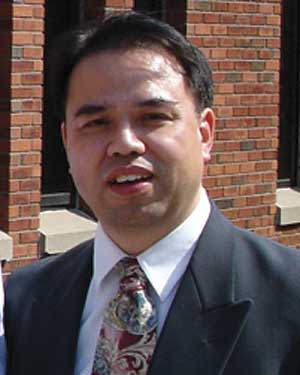A Column of Support








May 14, 2008
BY Jerry W. Kram
Augsburg College, tucked away in downtown Minneapolis, probably isn't the first institution that comes to mind in a discussion of cutting-edge scientific research. However, the school has a stellar reputation as a leading undergraduate educational institution. It counts among its alumni a Nobel Prize winner in chemistry-Peter Agre, class of 1970, Nobel Laureate, 2003-something many larger institutions cannot brag about. This level of excellence in the sciences has led to an innovation which may change the face of the biodiesel industry.
Brian Krohn, now a senior at Augsburg, worked with his advisor, Arlin Gyberg, to select a research project for his chemistry major. The research project is a requirement for graduation at Augsburg. Both men had an interest in biofuels, so Krohn decided to investigate the chemistry of manufacturing biodiesel. "Without Brian being interested in this project we never would have started," Gyberg says. "We decided to do a very thorough literature search on this. So he spent the first two or three weeks doing an extensive literature search looking at more than 1,000 articles, which he narrowed down to 100. Out of that we ran across two papers that caught our eye."
The papers discussed esterification catalyzed by solid strong acids including sulfated zirconia to manufacture biodiesel. Gyberg first attempted to make biodiesel using zirconia as a catalyst by mixing powdered zirconia with alcohol and vegetable oil in a batch process. It was a total failure. He believed there wasn't enough contact between the catalyst and the reactants. Gyberg wasn't ready to give up though. With a background in chromatography, which uses columns of chemically active solids to separate mixtures of chemicals, he wondered if a similar column could be used to make biodiesel. He contacted an Augsburg alumnus, Clayton McNeff, who had formed a company, ZirChrom Separations Inc., to sell a chromatography method using zirconia that he developed for another of his companies, Sartec. Corp. "One of the papers had mentioned zirconia-based catalysts," Gyberg says. "Nobody out there had ever thought of zirconia being a catalyst because they're chromatographers."
McNeff was startled at the idea that the zirconia used in the high-performance liquid chromatography (HPLC) columns could be used as a catalyst because the main idea of chromatography is to separate mixtures of chemicals without changing them. The most common use of HPLC is by the pharmaceutical industry to identify, separate, test and purify drugs and other products. "We were aware there were other uses for these compounds," McNeff says. "We knew that zirconia was used for catalytic cracking in the petroleum industry, but that was gas-phase cracking. But we didn't have a lot of fundamental knowledge of those kinds of things. For this specific use, I was really unaware that they were being used for biodiesel."
Along with fellow scientist Ben Yan, Gyberg and McNeff built and tested a column that mixed oil and alcohol with the catalyst under high heat and pressure until the mix became supercritical, a state where the mixture had properties of both a gas and a liquid. In the column, under the right conditions, the oil and alcohol were converted into biodiesel in six seconds. "The process of running the reactants through the stainless steel tube that had the catalyst in it at elevated temperature and pressure worked, and it worked much better than we had ever expected it could," McNeff says. "We started working at lower temperatures but as we raised the temperature the time it took to do the reaction went down.
Finally, we reached a temperature where the conversion took just five or six seconds." McNeff, Gyberg and Yan applied for a patent for the method, which they have dubbed the Mcgyan process.
The column allows for continuous production of biodiesel as opposed to the current batch method of production, Gyberg says. A column about 6 inches in diameter and 6 feet long will be able to produce 2.2 million gallons of biodiesel per year. Because the reactor is so small, it takes a relatively small amount of energy to keep it at the operating temperature using insulation and a heat recovery system. "The energy needs for the system really aren't very different than for the traditional process," McNeff says. "Since you can recover a lot of the energy coming out of the system and exchange with the fluid coming into the reactor, you only have to make up the thermal losses. When you insulate it and keep it in a controlled environment, you only have to make up maybe a small percent of the heat."
The process can also convert excess alcohols into ethers, which are more valuable in the current market. "If you use methanol you get dimethyl ether, which is the propellant used in hair sprays," McNeff says. "It can also be burned in a diesel engine. It is a very nice renewable-type fuel." The catalyst even dehydrates glycerin into other chemicals that act as additives to improve the quality of the resulting biodiesel, which increases the amount of biodiesel produced from a pound of vegetable oil. McNeff says these reactions can be encouraged or discouraged by changing the temperature and pressure inside the column. A further advantage of the process is that it isn't affected by the presence of water. "You don't have to use bone-dry ethanol," he adds. That means a Mcgyan-based plant can use hydrous ethanol as a feedstock thus lowering the plant's operating costs. Ethanol forms diethyl ether in the process which is used in starting fluid. It sells for $1 a pound or about $6 a gallon, which gives the process an additional significant revenue stream.
A pilot plant using the Mcgyan process has been running for six months, using a wide range of feedstocks with no problems, Gyberg says. The pilot facility fits into a couple of trailers that could be pulled behind a car. Each of the trailers holds a different step in the production process. "The entire process could be reduced to fit into a single semitrailer," McNeff says. "It could be used as a mobile unit to produce millions of gallons as it goes from site to site."
McNeff formed a company, Ever Cat Fuels LLC, to build a commercial-size 3 MMgy biodiesel facility in Isanti, Minn. The location was chosen for its proximity to the Twin Cities where the prinicipals of the company reside, so they could keep a close eye on the engineering and construction process. The name of the company is based on the idea that the zirconia will be an everlasting catalyst. The company broke ground in November and, if permitting goes as planned, it should be in operation by October. "The purpose of the Ever Cat plant is to scale this technology into a meaningful demonstration scale," McNeff says. "In the next three to five years we intend to scale it up to 30 MMgy. To reach 30 million gallons will only take 14 reactors. So it is a very small footprint. The biggest structure there is going to be the tank farm." The Ever Cat site is only three acres with a 10,000-square-foot building. The process area itself is only 2,000 square feet.
The plant will operate using hydrous ethanol rather than methanol and corn oil extracted from distillers grains as the feedstock. The feedstock will have up to 15 percent free fatty acids (FFAs) with an acid number of 30, which renders it almost useless for traditional biodiesel production. The Mcgyan process converts free fatty acids to biodiesel as easily as triglycerides. "The process converts it 100 percent to biodiesel with essentially no waste," Gyberg says. McNeff adds that the higher the free fatty acid content, the better the process works. The company is working on testing tall oil fatty acids, a byproduct of the pulp and paper industry which is almost pure FFAs. "The more FFAs, the more it loves it," McNeff says. "We can do 100 percent conversion of tall oil and the properties of the biodiesel are tremendous-a cloud point of minus 15 degrees Celsius (5 degrees Fahrenheit) and a very high cetane number."
The pilot-scale facility has proven that the process is nearly emissions free, which simplified the permitting process for the Isanti plant, McNeff says. "In talking to the Minnesota Pollution Control Agency, they indicated that we should withdraw our permit application because we're not emitting anything they see as an issue," he says. "There's really no permit required because the plant is so clean."
Furthermore, the biodiesel coming out at the end of the process doesn't need to be washed. Any excess methanol or reaction products are extracted from the biodiesel in a fractionating still. That, plus the use of feedstocks from a nearby ethanol plant, will make Ever Cat's cost of production nearly $2 per gallon lower than other biodiesel plants. "Ninety percent plus of the cost of biodiesel is in the feedstock," McNeff says. "We will be using oil extracted from distillers grains at 25 to 30 cents a pound while soybean oil is 63 cents a pound. Just that difference in feedstock costs is a tremendous economic advantage. The economics work even without a price support."
One additional aspect of the process Ever Cat is experimenting with is using different alcohols in the esterification process. Most biodiesel is the methyl ester made with methanol. McNeff says using longer chain alcohols such as propanol and butanol offer some distinct advantages. In particular, butyl fatty acid esters have a cloud point that is 10 degrees C (18 degrees F) lower than methyl esters. "If you combine tall oil and butyl alcohol, it is possible that you might get a biodiesel with a cloud point that is minus 25 degrees Celsius (minus 13 degrees F)."
When the Ever Cat plant is operational and successful, McNeff plans to license the technology to other companies. The researchers have formed another company, McNeff Research Consultants, to license the eight pending patents for the Mcgyan technology. "We hope that this will allow the industry to retrofit and become multifeedstock and multiproduct capable," McNeff says. "It takes us away from using food to using feedstocks that are much more acceptable to the public."
Ever Cat is also looking beyond traditional sources of feedstocks for biodiesel. The company has a cooperative agreement with Great River Energy to develop an algae production system. "We also have a grant from Excel Energy," McNeff adds. "We see algae as being a nice feedstock for the Mcgyan process because you typically get a high free fatty acid content in that oil. That high FFA content works well with our ability to make fuel out of those types of materials."
Jerry W. Kram is a Biodiesel Magazine staff writer. Reach him at jkram@bbibiofuels.com or (701) 738-4962.
Brian Krohn, now a senior at Augsburg, worked with his advisor, Arlin Gyberg, to select a research project for his chemistry major. The research project is a requirement for graduation at Augsburg. Both men had an interest in biofuels, so Krohn decided to investigate the chemistry of manufacturing biodiesel. "Without Brian being interested in this project we never would have started," Gyberg says. "We decided to do a very thorough literature search on this. So he spent the first two or three weeks doing an extensive literature search looking at more than 1,000 articles, which he narrowed down to 100. Out of that we ran across two papers that caught our eye."
The papers discussed esterification catalyzed by solid strong acids including sulfated zirconia to manufacture biodiesel. Gyberg first attempted to make biodiesel using zirconia as a catalyst by mixing powdered zirconia with alcohol and vegetable oil in a batch process. It was a total failure. He believed there wasn't enough contact between the catalyst and the reactants. Gyberg wasn't ready to give up though. With a background in chromatography, which uses columns of chemically active solids to separate mixtures of chemicals, he wondered if a similar column could be used to make biodiesel. He contacted an Augsburg alumnus, Clayton McNeff, who had formed a company, ZirChrom Separations Inc., to sell a chromatography method using zirconia that he developed for another of his companies, Sartec. Corp. "One of the papers had mentioned zirconia-based catalysts," Gyberg says. "Nobody out there had ever thought of zirconia being a catalyst because they're chromatographers."
McNeff was startled at the idea that the zirconia used in the high-performance liquid chromatography (HPLC) columns could be used as a catalyst because the main idea of chromatography is to separate mixtures of chemicals without changing them. The most common use of HPLC is by the pharmaceutical industry to identify, separate, test and purify drugs and other products. "We were aware there were other uses for these compounds," McNeff says. "We knew that zirconia was used for catalytic cracking in the petroleum industry, but that was gas-phase cracking. But we didn't have a lot of fundamental knowledge of those kinds of things. For this specific use, I was really unaware that they were being used for biodiesel."
Along with fellow scientist Ben Yan, Gyberg and McNeff built and tested a column that mixed oil and alcohol with the catalyst under high heat and pressure until the mix became supercritical, a state where the mixture had properties of both a gas and a liquid. In the column, under the right conditions, the oil and alcohol were converted into biodiesel in six seconds. "The process of running the reactants through the stainless steel tube that had the catalyst in it at elevated temperature and pressure worked, and it worked much better than we had ever expected it could," McNeff says. "We started working at lower temperatures but as we raised the temperature the time it took to do the reaction went down.
Finally, we reached a temperature where the conversion took just five or six seconds." McNeff, Gyberg and Yan applied for a patent for the method, which they have dubbed the Mcgyan process.
The column allows for continuous production of biodiesel as opposed to the current batch method of production, Gyberg says. A column about 6 inches in diameter and 6 feet long will be able to produce 2.2 million gallons of biodiesel per year. Because the reactor is so small, it takes a relatively small amount of energy to keep it at the operating temperature using insulation and a heat recovery system. "The energy needs for the system really aren't very different than for the traditional process," McNeff says. "Since you can recover a lot of the energy coming out of the system and exchange with the fluid coming into the reactor, you only have to make up the thermal losses. When you insulate it and keep it in a controlled environment, you only have to make up maybe a small percent of the heat."
The process can also convert excess alcohols into ethers, which are more valuable in the current market. "If you use methanol you get dimethyl ether, which is the propellant used in hair sprays," McNeff says. "It can also be burned in a diesel engine. It is a very nice renewable-type fuel." The catalyst even dehydrates glycerin into other chemicals that act as additives to improve the quality of the resulting biodiesel, which increases the amount of biodiesel produced from a pound of vegetable oil. McNeff says these reactions can be encouraged or discouraged by changing the temperature and pressure inside the column. A further advantage of the process is that it isn't affected by the presence of water. "You don't have to use bone-dry ethanol," he adds. That means a Mcgyan-based plant can use hydrous ethanol as a feedstock thus lowering the plant's operating costs. Ethanol forms diethyl ether in the process which is used in starting fluid. It sells for $1 a pound or about $6 a gallon, which gives the process an additional significant revenue stream.
A pilot plant using the Mcgyan process has been running for six months, using a wide range of feedstocks with no problems, Gyberg says. The pilot facility fits into a couple of trailers that could be pulled behind a car. Each of the trailers holds a different step in the production process. "The entire process could be reduced to fit into a single semitrailer," McNeff says. "It could be used as a mobile unit to produce millions of gallons as it goes from site to site."
McNeff formed a company, Ever Cat Fuels LLC, to build a commercial-size 3 MMgy biodiesel facility in Isanti, Minn. The location was chosen for its proximity to the Twin Cities where the prinicipals of the company reside, so they could keep a close eye on the engineering and construction process. The name of the company is based on the idea that the zirconia will be an everlasting catalyst. The company broke ground in November and, if permitting goes as planned, it should be in operation by October. "The purpose of the Ever Cat plant is to scale this technology into a meaningful demonstration scale," McNeff says. "In the next three to five years we intend to scale it up to 30 MMgy. To reach 30 million gallons will only take 14 reactors. So it is a very small footprint. The biggest structure there is going to be the tank farm." The Ever Cat site is only three acres with a 10,000-square-foot building. The process area itself is only 2,000 square feet.
The plant will operate using hydrous ethanol rather than methanol and corn oil extracted from distillers grains as the feedstock. The feedstock will have up to 15 percent free fatty acids (FFAs) with an acid number of 30, which renders it almost useless for traditional biodiesel production. The Mcgyan process converts free fatty acids to biodiesel as easily as triglycerides. "The process converts it 100 percent to biodiesel with essentially no waste," Gyberg says. McNeff adds that the higher the free fatty acid content, the better the process works. The company is working on testing tall oil fatty acids, a byproduct of the pulp and paper industry which is almost pure FFAs. "The more FFAs, the more it loves it," McNeff says. "We can do 100 percent conversion of tall oil and the properties of the biodiesel are tremendous-a cloud point of minus 15 degrees Celsius (5 degrees Fahrenheit) and a very high cetane number."
The pilot-scale facility has proven that the process is nearly emissions free, which simplified the permitting process for the Isanti plant, McNeff says. "In talking to the Minnesota Pollution Control Agency, they indicated that we should withdraw our permit application because we're not emitting anything they see as an issue," he says. "There's really no permit required because the plant is so clean."
Furthermore, the biodiesel coming out at the end of the process doesn't need to be washed. Any excess methanol or reaction products are extracted from the biodiesel in a fractionating still. That, plus the use of feedstocks from a nearby ethanol plant, will make Ever Cat's cost of production nearly $2 per gallon lower than other biodiesel plants. "Ninety percent plus of the cost of biodiesel is in the feedstock," McNeff says. "We will be using oil extracted from distillers grains at 25 to 30 cents a pound while soybean oil is 63 cents a pound. Just that difference in feedstock costs is a tremendous economic advantage. The economics work even without a price support."
One additional aspect of the process Ever Cat is experimenting with is using different alcohols in the esterification process. Most biodiesel is the methyl ester made with methanol. McNeff says using longer chain alcohols such as propanol and butanol offer some distinct advantages. In particular, butyl fatty acid esters have a cloud point that is 10 degrees C (18 degrees F) lower than methyl esters. "If you combine tall oil and butyl alcohol, it is possible that you might get a biodiesel with a cloud point that is minus 25 degrees Celsius (minus 13 degrees F)."
When the Ever Cat plant is operational and successful, McNeff plans to license the technology to other companies. The researchers have formed another company, McNeff Research Consultants, to license the eight pending patents for the Mcgyan technology. "We hope that this will allow the industry to retrofit and become multifeedstock and multiproduct capable," McNeff says. "It takes us away from using food to using feedstocks that are much more acceptable to the public."
Ever Cat is also looking beyond traditional sources of feedstocks for biodiesel. The company has a cooperative agreement with Great River Energy to develop an algae production system. "We also have a grant from Excel Energy," McNeff adds. "We see algae as being a nice feedstock for the Mcgyan process because you typically get a high free fatty acid content in that oil. That high FFA content works well with our ability to make fuel out of those types of materials."
Jerry W. Kram is a Biodiesel Magazine staff writer. Reach him at jkram@bbibiofuels.com or (701) 738-4962.
Advertisement
Advertisement
Upcoming Events





